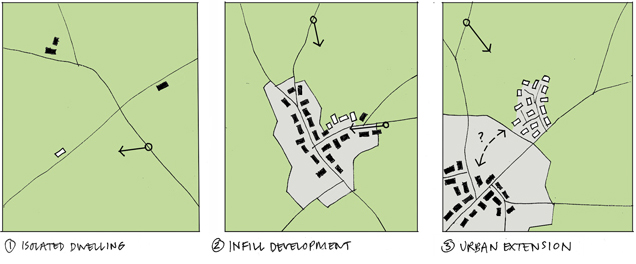I recently attended a ‘stakeholder workshop’ on South Norfolk’s new draft design guide being prepared by the Council’s own Design and Conservation team and Tibbalds. It was an interesting session. I was quite encouraged at the widely held opinion in the room that perhaps the emphasis should be more forward-looking, focussing as much on C21st best-practice as on mediaeval town centres – a problem I have written about previously on Ruralise, here in particular.
After the event I got to thinking about the whole issue of ‘fitting in’ – and summarised my thoughts in a series of diagrams, distinguising between three different types of rural context, which a new building might respond to:
1) An isolated dwelling (or small group of dwellings) will always be read as part of a landscape and would reasonably be required to be respectful to that landscape. In this context, ideas about the classic ‘single-pile’ house with the steeply pitched roof might be particularly relevant – but (in my view) with a strong suggestion that contemporary designs which make these connections would be particularly welcome. Because of existing constraints on rural development, this type of project is extremely rare – though the Community Right to Build may change this.
2) An infill development might similarly be read as part of a landscape-vista but will probably also be read against existing buildings in a village. In my view it should be sympathetic to whatever the immediate context is, especially if it is a Conservation Area. In that case the context could be mediaeval or Victorian buildings – but it could also include 1930s or 50s council housing, or 60s/70s chalet bungalows, or 80s/90s ‘Barratt houses’. What then?
3) An urban extension may also form part of a landscape-vista or a view of an urban edge. But it is quite likely to be a long way from any mediaeval/Victorian buildings – so why would they be relevant? And even if there is a close proximity, what is to stop the new development having its own distinctly C21st character.
I think the ‘acid test’ should be: does the development form part of a larger and precious whole – a landscape or an attractive street-scene? If so, perhaps it should ‘resonate’ with that context (no more than resonate, in my opinion) but if it doesn’t, why shouldn’t it draw its inspiration from elsewhere? Edinburgh New Town owes very little to Edinburgh’s mediaeval high-street, but we wouldn’t criticise for not ‘fitting in’ or failing to be ‘locally distinctive’, would we?
Next: More on ‘Local Distinctiveness‘

